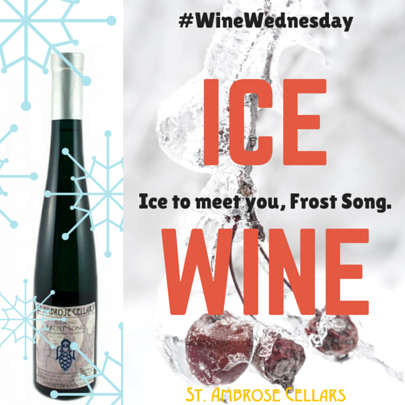
Ice Wines – #WineWednesday
The weather outside is frightful, and that’s quite delightful for some .. including ice wine connoisseurs.
Ice wine? The heck is that?
You might be thinking about a glass of red that some barbarian dropped an ice cube into it, but we assure you, that’s incorrect.
Ice wine is a specialty wine that’s made from grapes which have frozen a bit while still on the vine. Normally you want to harvest your grapes (or anything, really) well before the frosts and ice start, but this is an exception.
The sugars of these grapes are not frozen, but the water in the grape is, which makes for a concentrated grape must to be extracted during the pressing process. The resulting wine ends up being heavily concentrated, almost “thick”, and very sweet.
The history of ice wine may trace all the way back to the Roman Empire, where it was written that some grape varieties were not harvested until the first frost. We don’t have any exact confirmation on the how and why – at least until we get a time machine – so we have to settle and say the first documented ice wine was likely created in Germany in the 1700s. The first extensively documented harvest of ice wine was in 1830, also in Germany. From these humble beginnings, the art of ice wine emerged.
Throughout its history, ice wine harvests have been relatively rare and difficult. To produce ice wine, one must be ready to harvest grapes at the first opportunity and get to work – requiring prep and planning for an event that may not happen. While lucky folks like us in Northern Michigan and our Canadian friends can count on winter coming at some point, the perfect conditions for ice wine (and the grapes required) don’t always lineup, even here.
To count as an ice wine by regulations, the grapes need to go through a “hard freeze”, while on the vine, after they are ripe. Freezing after harvest, light frosts, and such do not count. For a good ice wine crop, one needs the freeze to arrive before the grapes have rotted too much, and the freeze must be hard, but not so severe that it is impossible to extract the juices. It’s a slippery business. While waiting for these “just-right” conditions, one must also protect the grapes from wild animals and other forces of nature.
So, the freeze happens, everything is great, now what?
The grapes need to be harvested practically immediately. Then they need to pressed, while still frozen. This means a long day and night for the workers, between harvesting and then working to press the precious ice grapes in an environment where they stay frozen. Sound cozy?
After pressing, patience takes over. Ice wine does not ferment as quickly as other wines. The erratic nature of the harvest, difficulties of the harvest, and long fermentation add up to a wine that tends to hit you in the wallet a bit harder than some other varieties.
Our foray into the ice wine world is Frost Song. This dry ice wine brings together some interesting flavors – peach pie, pears, and raisins, for instance – for a unique tasting experience. We recommend that you pair it with a hard cheese.
Our Late Harvest wines are similar to ice wine, but not quite the same. Late Harvest wines do not have the same exacting specifications as a true ice wine, but are similar in their profile. It’s a story for a different time…

